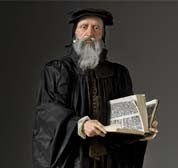Mary, Mother of God

What is the meaning of “conceived by the Holy Ghost, born of the virgin Mary?"
That the eternal Son of God, who is and continues true and eternal God, took upon Himself the very nature of man, of the flesh and blood of the virgin Mary, by the operation of the Holy Ghost, so that He might also be the true seed of David, like unto His brethren in all things, except for sin.
The Heidelberg Catechism, Q & A 35
The Council of Ephesus (also known as the Third Ecumenical Council) met in 431 A.D. to confront a heresy called Nestorianism. The Nestorius controversy centered on the term “Mother of God.” Instead of Theotokos (Mother of God), Nestorius (c. 381–c. 451) taught that Mary was Christotokos, or “Mother of Christ.” In a nutshell, Nestorius claimed that Jesus was two persons (one human, the other divine) in one body, and that Mary only gave birth to the “human” part, not the divine.
The council declared Nestorianism heresy and affirmed the Nicene Creed (325, 381) which maintained that Christ was both human and divine and “incarnate of the Holy Spirit and the Virgin Mary . . .”
What Say Protestants
Protestants affirm the Nicene Creed and the Council of Ephesus. Consequently, we affirm the statement that Mary is the mother of God. That being said, I do have a recommendation for when you’re discussing this: clearly define what you mean when you use the term. Here’s why. Consider the following syllogism:
Mary is the mother of Jesus.
Jesus is God.
Therefore, Mary is the mother of God.
So far so good; but then . . .
Mary is the mother of God.
God is a Trinity.
Therefore, Mary is the mother of the Trinity.
You can see how this can get away from you. For this reason it’s important that you understand and clearly communicate the doctrine of the incarnation, so that it’s clear what you mean by Mary being the mother of God. I particularly favor the Athanasian Creed (c. 500) on this topic.
Named after Athanasius (293–373 A.D.), defender of the Trinity against another Christological heresy, Arianism
(great granddaddy to the Jehovah Witnesses), the creed comprises two parts: the first sets forth the doctrine of the Trinity, and the second the incarnation and dual natures of Christ. Here’s a portion:
. . . The right faith therefore is that we believe and confess that our Lord Jesus Christ, the Son of God, is God and Man. He is God of the substance of the Father begotten before the worlds, and He is man of the substance of His mother born in the world; perfect God, perfect man subsisting of a reasoning soul and human flesh; equal to the Father as touching His Godhead, inferior to the Father as touching His Manhood. Who although He be God and Man yet He is not two but one Christ; one however not by conversion of the Godhead in the flesh, but by taking of the Manhood in God; one altogether not by confusion of substance but by unity of Person. For as the reasoning soul and flesh is one man, so God and Man is one Christ . . .
Can’t Get Enough of Mary?
On a similar note, Rev. Lee Johnson at the Two-Edged Sword blog has two great posts pertaining to Mary:
- Rejecting Mariology
Did the early church fathers believe that Mary was sinless? Did they worship her? In this post Rev. Johnson provides the history behind Mary’s rise to veneration. - Roman Degradation of Mary
Was Mary sinless? Was she perpetually a virgin? Here Rev. Johnson answers the charge that Protestants degrade Mary and shows that it’s actually Rome who’s doing the degrading by making her into something she’s not.
--The Catechizer
Labels: Creeds Confessions and Catechisms, Doctrine of God, Heresy and False Religions, History




0 Comments:
Post a Comment
<< Home